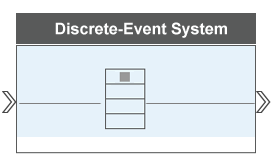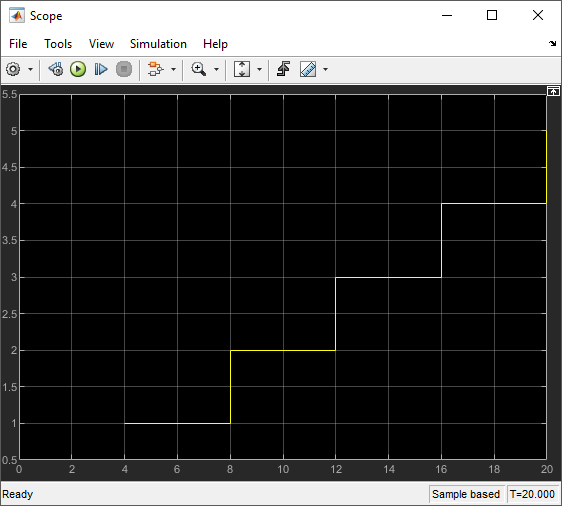Delay Entities with a Custom Entity Storage Block
This example shows how to use discrete-event System object™ methods to create a custom entity storage block that has one input port,
one output port, and one storage element. The discrete-event System object is the instantiation of the matlab.DiscreteEventSystem class, which
allows you to use the implementation and service methods provided by this class. Then,
you use the MATLAB Discrete-Event System block to
integrate the System object into a SimEvents® model.
The custom MATLAB Discrete-Event System block accepts an entity from its input port and forwards it to its output port with a specified delay. The figure visualizes the block using the discrete-event system framework.
To open the model and to observe the behavior of the custom block, see CustomEntityStorageBlockExample.

Create the Discrete-Event System Object
Create a new script and inherit the
matlab.DiscreteEventSystemclass.classdef CustomEntityStorageBlock < matlab.DiscreteEventSystemAdd a custom description to the block.
% A custom entity storage block with one input, one output, and one storage.Declare two nontunable parameters
CapacityandDelayto represent the storage capacity and the entity departure delay from the storage.% Nontunable properties properties (Nontunable) % Capacity Capacity = 1; % Delay Delay = 4; end
The parameters capture the properties of the block.
Tunable parameters can be tuned during run time.
Non-tunable parameters cannot be tuned during run time.
Specify these methods and set access to protected.
methods (Access = protected) % Specify the number of input ports. function num = getNumInputsImpl(~) num = 1; end % Specify the number of output ports. function num = getNumOutputsImpl(~) num = 1; end % Specify a new entity type Car. function entityTypes = getEntityTypesImpl(obj) entityTypes = obj.entityType('Car'); end % Specify Car as the entity type that is used in % input and output ports. function [inputTypes,outputTypes] = getEntityPortsImpl(obj) inputTypes = {'Car'}; outputTypes = {'Car'}; end % Specify the storage type, capacity, and connection to % the input and output ports. function [storageSpecs, I, O] = getEntityStorageImpl(obj) storageSpecs = obj.queueFIFO('Car', obj.Capacity); % First element of I indicates the entity storage index 1 that is % connected to input 1. I = 1; % First element of O indicates the entity storage index 1 that is % connected to output 1. O = 1; end endOnly one storage sorts cars in a first-in-first-out (FIFO) manner. The
Capacityparameter of the object defines the server capacity.The method
getEntityStorageImpl()also specifies the connections between the ports and the storage,IandO.The return value
Iis a vector of elements i =1, ...n where its length n is equal to the number of input ports.In this example,
nis1because only one input port is declared.The ith element indicates the entity storage index that the ith input port connects to.
In this example, input port
1is connected to storage1.If an input port is a signal port, the corresponding element is
0.
Similarly the return value
Ois used to define the connections between the storage and the output port.Specify an
eventForwardevent to forward an entity of typeCarto the output when it enters the storage.function [entity,event] = CarEntry(obj,storage,entity,source) % Specify event actions when entity enters storage. event = obj.eventForward('output', 1, obj.Delay); end
A
Carentry to the storage invokes an event action and the eventobj.eventForwardforwardsCarto the output with index1with a delay specified byobj.Delay.You can use the input arguments of this method to create custom behavior. The argument
objis the discrete-event System object inherited by the method. The argumentstorageis the index of the storage element that the entity enters. The argumententityis the entity that enters the storage and it has two fields,entity.sysandentity.data. The argumentsourceis the source location of the entity that enters the storage.Note
You cannot manipulate entity data within an exit action.
Name your discrete-event System object
CustomEntityStorageBlockand save it asCustomEntityStorageBlock.m.The custom block represents a simplified gas station that can serve one car at a time. A car arrives at the gas station and is serviced for 4 minutes before departing the station.
Implementing the Custom Entity Storage Block
Create a model using an Entity Generator block, MATLAB Discrete-Event System block, and an Entity Terminator block.

Open the MATLAB Discrete-Event System block, and set the Discrete-event System object name to
CustomEntityStorageBlock.
Double-click the MATLAB Discrete-Event System block to observe its capacity and delay.

Output the Number of entities arrived, a statistic from the Entity Terminator block and connect it to a scope
Increase the simulation time to
20and run the simulation. Observe the entities arriving at the Entity Terminator block with a delay of4.
See Also
matlab.DiscreteEventSystem | entry | matlab.System | getEntityStorageImpl | getEntityPortsImpl | getEntityTypesImpl

